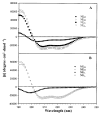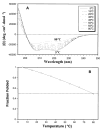Rational design of alpha-helical antimicrobial peptides with enhanced activities and specificity/therapeutic index
- PMID: 15677462
- PMCID: PMC1393284
- DOI: 10.1074/jbc.M413406200
Rational design of alpha-helical antimicrobial peptides with enhanced activities and specificity/therapeutic index
Abstract
In the present study, the 26-residue peptide sequence Ac-KWKSFLKTFKSAVKTVLHTALKAISS-amide (V681) was utilized as the framework to study the effects of peptide hydrophobicity/hydrophilicity, amphipathicity, and helicity (induced by single amino acid substitutions in the center of the polar and nonpolar faces of the amphipathic helix) on biological activities. The peptide analogs were also studied by temperature profiling in reversed-phase high performance liquid chromatography, from 5 to 80 degrees C, to evaluate the self-associating ability of the molecules in solution, another important parameter in understanding peptide antimicrobial and hemolytic activities. A higher ability to self-associate in solution was correlated with weaker antimicrobial activity and stronger hemolytic activity of the peptides. Biological studies showed that strong hemolytic activity of the peptides generally correlated with high hydrophobicity, high amphipathicity, and high helicity. In most cases, the D-amino acid substituted peptides possessed an enhanced average antimicrobial activity compared with L-diastereomers. The therapeutic index of V681 was improved 90- and 23-fold against Gram-negative and Gram-positive bacteria, respectively. By simply replacing the central hydrophobic or hydrophilic amino acid residue on the nonpolar or the polar face of these amphipathic derivatives of V681 with a series of selected D-/L-amino acids, we demonstrated that this method has excellent potential for the rational design of antimicrobial peptides with enhanced activities.
Figures






Similar articles
-
Role of helicity of α-helical antimicrobial peptides to improve specificity.Protein Cell. 2014;5(8):631-42. doi: 10.1007/s13238-014-0061-0. Epub 2014 May 9. Protein Cell. 2014. PMID: 24805306 Free PMC article.
-
Effects of single D-amino acid substitutions on disruption of beta-sheet structure and hydrophobicity in cyclic 14-residue antimicrobial peptide analogs related to gramicidin S.J Pept Res. 2004 Feb;63(2):69-84. doi: 10.1046/j.1399-3011.2003.00106.x. J Pept Res. 2004. PMID: 15009528 Free PMC article.
-
Role of helicity on the anticancer mechanism of action of cationic-helical peptides.Int J Mol Sci. 2012;13(6):6849-6862. doi: 10.3390/ijms13066849. Epub 2012 Jun 5. Int J Mol Sci. 2012. PMID: 22837667 Free PMC article.
-
Dissociation of antimicrobial and hemolytic activities in cyclic peptide diastereomers by systematic alterations in amphipathicity.J Biol Chem. 1999 May 7;274(19):13181-92. doi: 10.1074/jbc.274.19.13181. J Biol Chem. 1999. PMID: 10224074
-
Strategies to Improve the Activity and Biocompatibility: Modification of Peptide Antibiotics.Foodborne Pathog Dis. 2022 Jun;19(6):376-385. doi: 10.1089/fpd.2021.0112. Foodborne Pathog Dis. 2022. PMID: 35713924 Review.
Cited by
-
The Design and Construction of K11: A Novel α-Helical Antimicrobial Peptide.Int J Microbiol. 2012;2012:764834. doi: 10.1155/2012/764834. Epub 2012 Feb 16. Int J Microbiol. 2012. PMID: 22518150 Free PMC article.
-
Antimicrobial, Insecticidal and Cytotoxic Activity of Linear Venom Peptides from the Pseudoscorpion Chelifer cancroides.Toxins (Basel). 2022 Jan 14;14(1):58. doi: 10.3390/toxins14010058. Toxins (Basel). 2022. PMID: 35051034 Free PMC article.
-
How do cyclic antibiotics with activity against Gram-negative bacteria permeate membranes? A machine learning informed experimental study.Biochim Biophys Acta Biomembr. 2020 Aug 1;1862(8):183302. doi: 10.1016/j.bbamem.2020.183302. Epub 2020 Apr 18. Biochim Biophys Acta Biomembr. 2020. PMID: 32311341 Free PMC article.
-
Antiplasmodial properties of acyl-lysyl oligomers in culture and animal models of malaria.Antimicrob Agents Chemother. 2011 Aug;55(8):3803-11. doi: 10.1128/AAC.00129-11. Epub 2011 Jun 6. Antimicrob Agents Chemother. 2011. PMID: 21646484 Free PMC article.
-
Enantiomeric Effect of d-Amino Acid Substitution on the Mechanism of Action of α-Helical Membrane-Active Peptides.Int J Mol Sci. 2017 Dec 27;19(1):67. doi: 10.3390/ijms19010067. Int J Mol Sci. 2017. PMID: 29280948 Free PMC article.
References
-
- Neu HC. Science. 1992;257:1064–1073. - PubMed
-
- Travis J. Science. 1994;264:360–362. - PubMed
-
- Calza L, Manfredi R, Chiodo F. Expert Opin Pharmacother. 2004;5:1899–1916. - PubMed
-
- Jacqueline C, Asseray N, Batard E, Mabecque VL, Kergueris MF, Dube L, Bugnon D, Potel G, Caillon J. Int J Antimicrob Agents. 2004;24:393–396. - PubMed
-
- Wagenlehner FM, Naber KG. Int J Antimicrob Agents. 2004;24(Suppl 1):39–43. - PubMed
Publication types
MeSH terms
Substances
Grants and funding
LinkOut - more resources
Full Text Sources
Other Literature Sources
Medical

